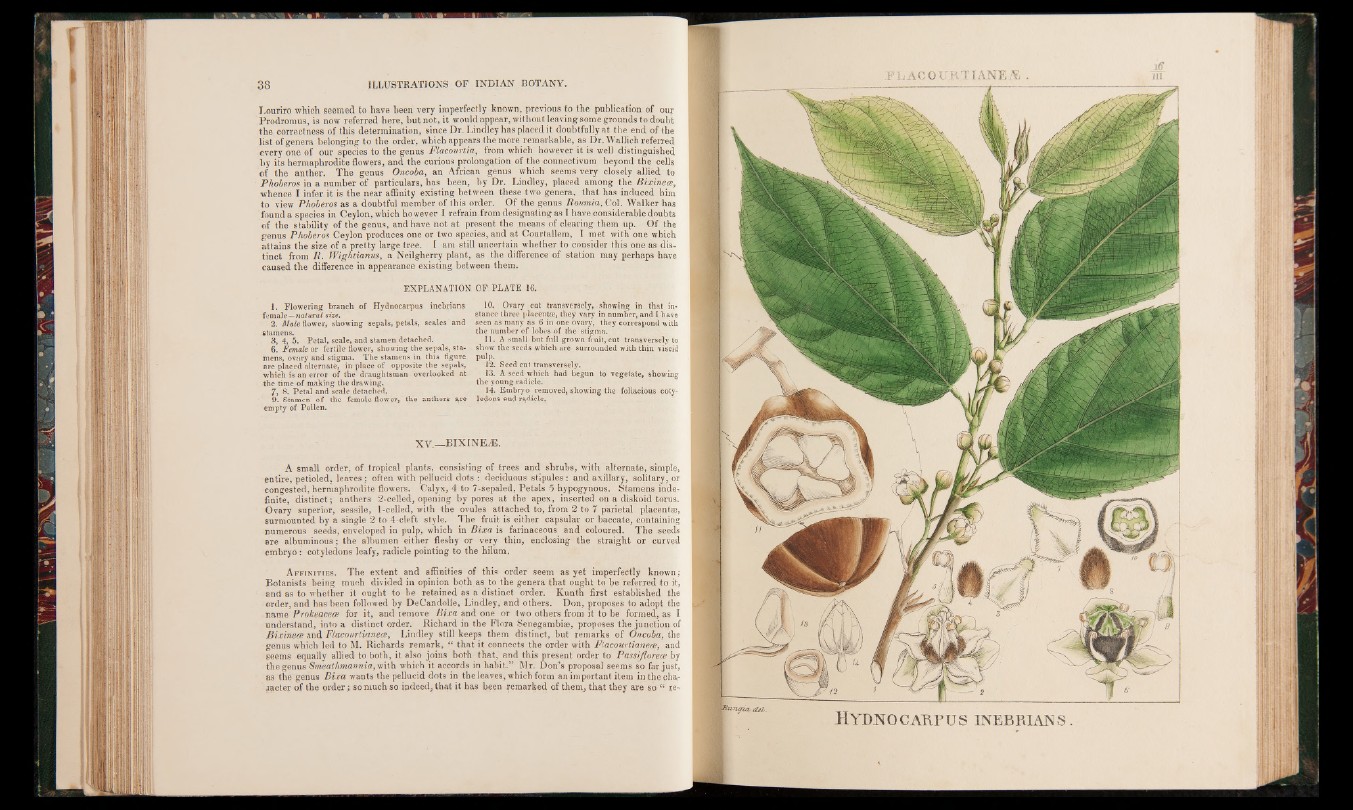
Louriro which seemed to have been very imperfectly known, previous to the publication of our
Prodromus, is now referred here, but not, it would appear, without leaving some grounds to doubt
the correctness of this determination, since Dr. Lindley has placed it doubtfully at the end of the
list of genera belonging to the order, which appears the more remarkable, as Dr. Wallich referred
every one of our species to the genus Flacourtia, from which however it is well distinguished
by its hermaphrodite flowers, and the curious prolongation of the connectivum beyond the cells
of the anther. The genus Oncoba, an African genus which seems very closely allied to
Phoberos in a number of particulars, has been, by Dr. Lindley, placed among the Bixinece,
whence I infer it is the near affinity existing between these two genera, that has induced him
to view Phoberos as a doubtful member of this order. Of the genus Roumia, Col. Walker has
found a species in Ceylon, which however I refrain from designating as I have considerable doubts
of the stability of the genus, and have not at present the means of clearing them up. Of the
genus Phoberos Ceylon produces one or two species, and at Courtallem, I met with one which
attains the size of a pretty large tree. I am still uncertain whether to consider this one as distinct
from R. Wightianns, a Neilgherry plant, as the difference of station may perhaps have
caused the difference in appearance existing between them.
EXPLANATION OF PLATE 16.
1. Flowering branch of Hydnocarpus inebrians
female—natural size.
2. Male flower, showing sepals, petals, scales and
stamens.
3. 4, 5. Petal, scale, and stamen detached.
6. Female or fertile flower, showing the sepals, stamens,
ovary and stigma. The stamens in this figure
are placed alternate, in place of opposite the sepals,
which is an error of the draughtsman overlooked at
the time of making the drawing,
7, 8. Petal and scale detached,
9. Stamen o f the female flower, the anthers are
empty of Pollen.
10. Ovary cut transversely, showing in that instance
three placentae, they vary in number, and I have
seen as many as 6 in one ovary, they correspond with
the number of lobes of the stigma.
11. A small but full grown fruit, cut transversely to
show the seeds which are surrounded with thin viscid
pulp.
12. Seed cut transversely.
13. A seed which had begun to vegetate, showing
the young, radicle.
14. Embryo removed, showing the fallacious cotyledons
and radicle.
XV.—B IX IN E ^ .
A small order, of tropical plants, consisting of trees and shrubs, with alternate, simple,
entire, petioled. leaves; often with pellucid dots : deciduous stipules : and axillary, solitary, or
congested, hermaphrodite flowers. Calyx, 4 to 7-sepaled, Petals 5 hypogynous. Stamens indefinite,
distinct; anthers 2-celled, opening by pores at the apex, inserted on a diskoid torus.
Ovary superior, sessile, 1-celled, with the ovules attached to, from 2 to 7 parietal placentas,
surmounted by a single 2 to 4-cleft style. The fruit is either capsular or baccate, containing
numerous seeds, enveloped in pulp, which in Bixa is farinaceous and coloured. The seeds
are albuminous; the albumen either fleshy or very thin, enclosing the straight or curved
embryo: cotyledons leafy, radicle pointing to the hilum.
Affinities. The extent and affinities of this order seem as yet imperfectly known;
Botanists being much divided in opinion both as to the genera that ought to be referred to it,
and as to whether it ought to be retained as a distinct order. Kunth first established the
order, and has been followed by DeCandolle, Lindley, and others. Don, proposes to adopt the
name Prokeacece for it, and iemove Bixa and one or two others from it to be formed, as I
understand, into a distinct order. Richard in the Flora Senegambise, proposes the junction of
Bixinece and Flacourtianece, Lindley still keeps them distinct, but remarks of Oncoba, the
genus which led to M. Richards remark, “ that it connects the order with Flacourtia new, and
seems equally allied to both, it also joins both that, and this present order to Passijlorece by
the genus Smeathmannia, with which it accords in habit.” Mr. Don’s proposal seems so far just,
as the genus Bixa wants the pellucid dots in the leaves, which form an important item in the character
of the order; so much so indeed, that it has been remarked, of them, that they are so “ re-
Hydnocarpus inebrians .